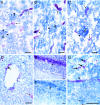Shiga toxin binding to isolated porcine tissues and peripheral blood leukocytes
- PMID: 15501802
- PMCID: PMC523021
- DOI: 10.1128/IAI.72.11.6680-6684.2004
Shiga toxin binding to isolated porcine tissues and peripheral blood leukocytes
Abstract
Shiga toxin (Stx) binding sites in porcine tissues and leukocytes were identified by the use of Stx overlay and anti-CD77/Gb3 immunoassays. Stx1 and Stx2 bound to similar tissue locations and leukocytes, although some differences were noted. Previously unreported Stx binding sites were identified in kidney tubules, intestinal lymphoid aggregates, sinusoidal liver cells, alveolar macrophages, and peripheral blood leukocytes.
Figures


References
-
- Barnes, D., S. Aggarwal, S. Thomsen, M. Fitzmaurice, and R. Richards-Kortum. 1993. A characterization of the fluorescent properties of circulating human eosinophils. Photochem. Photobiol. 58:297-303. - PubMed
-
- Boyd, B., G. Tyrrell, M. Maloney, C. Gyles, J. Brunton, and C. Lingwood. 1993. Alteration of the glycolipid binding specificity of the pig edema toxin from globotetraosyl to globotriaosyl ceramide alters in vivo tissue targeting and results in a verotoxin 1-like disease in pigs. J. Exp. Med. 177:1745-1753. - PMC - PubMed
-
- Chark, D., A. Nutikka, N. Trusevych, J. Kuzmina, and C. Lingwood. 2004. Differential carbohydrate epitope recognition of globotriaosyl ceramide by verotoxins and a monoclonal antibody. Eur. J. Biochem. 271:405-417. - PubMed
MeSH terms
Substances
LinkOut - more resources
Full Text Sources

